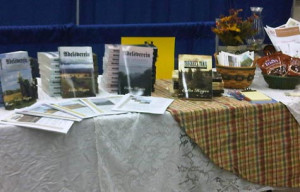We have carried on with watching Upstairs, Downstairs – warming up to it every evening with a half-hour palate cleanser of Blandings … which reminds me, I must steer my daughter towards those copies of PG Wodehouse which I have on the shelves, and my volume of the collected works of Saki, otherwise HH Munro … a writer of short stories only equal in my estimation to Rudyard Kipling … whose collections I also have on the shelves. Yes, HH Munro died in WWI, and so did Kipling’s only son, John. One was in his forties and over-aged for the military combat duties, the other seventeen and a trifle young for it … but they both rushed to join the forces, such was the tone of the time. (Munro turned down a commission and served in the ranks, John Kipling’s influential father wrangled his near-sighted son a commission in the Irish Guards.)
This once-proud and forward-thinking world and it’s brutal disillusion is reflected in the current series of Upstairs, Downstairs – first, the tenor of the time, of optimistic patriotism, outrage at German brutality in Belgium and France, the honestly-felt obligation to serve King and country … and then shading into war-weariness and despair, as the casualties mounted, up and up and up. England, France, Germany and Russia were gutted of a whole generation of men – some time in college (or maybe it was a grad school course) there was reason in one of my textbooks for a couple of tables of statistics for males by age in certain Western European countries. There was a considerable divot when it came to the male population of certain countries who would have been of an age to serve in WWI. That was statistics on a page; brought home now and again by the local war memorials in various towns all across Britain, France and Germany – a small stone obelisk in a corner of the town square, or a panel let into the side of a wall, with fifteen or twenty names on it. Heartbreakingly – especially in smaller places – there would be a couple or three identical surnames. Brothers, fathers and sons, cousins … the only wartime losses in the US to equal the English toll in WWI had happened fifty years before, in the Civil War, when local companies went down in sheaves like wheat under the scythe, in a storm of shot where the minie balls came down like hail, and there went just all about the fit men of age from some small town in Illinois, or Virginia, Vermont or Ohio, in some contested field – a sunken road, a wheat-field, a peach orchard or an angle of trench.
In Upstairs, Downstairs, this carnage all happens off-stage. It was a television program after all – and even if by Season Four it was a winner in the popularity stakes, additional budget largess went to more scenes set on location, rather than the studio set, and rather better costuming for the female characters. I have not noticed so many eye-blindingly awful selections with obvious zippers up the back as there were in the first two seasons. It is telling, though – that the fashion for rather more practical and shorter skirts for every-day wear is quite obvious, although the older generation, exemplified by Lady Pru resolutely keeps to toe-length, and Mrs. Bridges holds on to the old-style of dress, apron and cap. The sun will never set on Mrs. Bridges in a hair-net and a knee-length dress.
James is a total and self-centered jerk … but there must have been something to him, else why would Hazel ever have seen something to him, and stuck around? Perhaps she was just out of her mind for a couple of months in 1912 or so. Poor Rose missed her chance of domestic happiness – kick and scream as she must, she’ll be the rest of her life in service. Hudson still holds up his end – although as blind as a bat himself, he had a go at volunteering for the Army. And there we stand, with four or five more episodes and the final season – the one which I never actually saw, since I was in the military myself and overseas when it aired on PBS the first time around.


Recent Comments